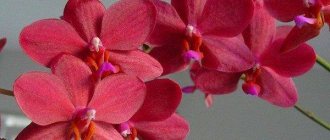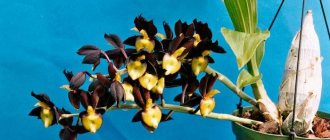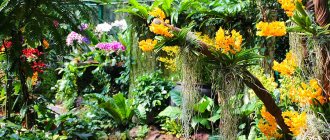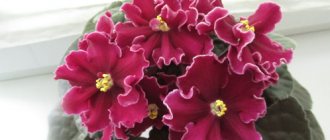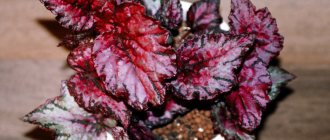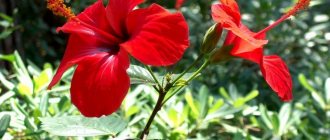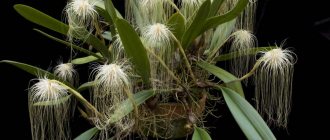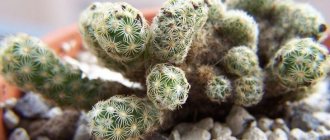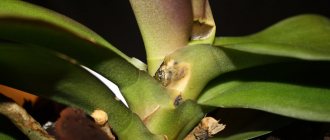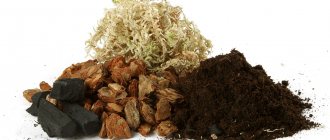Orchid is one of the most popular home flowering plants. Many gardeners love to grow them at home or in greenhouses. In nature there are a huge number of species and varieties of this flower: Brassia, Dracula, Cattleya. The monkey orchid got its name because of the unique appearance of the flower. This type has different color options: white, burgundy, dark green and so on. But all these flowers are united by the fact that the three petals are molded at the base and form, as it were, a single bowl, while they are extended outward. In home use, monkey orchid is quite rare.
Detailed description
The flower received its ominous name - Dracula (lat. Dracula) thanks to the inflorescence, which in appearance resembles the mouth of a dragon. Also, the plant does not like sunlight , just like the famous vampire.
All orchids of this species are characterized by small stems, soft spongy leaves and a specific flower shape: three sepals fused together, with long narrow projections at the ends. The petals have variegated colors and are often densely covered inside with hairs - trichomes. The large lip is shaped like a mushroom.
Dracula is an epiphytic plant. In nature, it grows on trees, but does not feed from them, but only uses them as a support.
History of the species, origin and place of residence
The Dracula orchid (lat. Dracula) is officially one of the top five most unusual representatives of its family.
The first species that was mentioned in print was called Masdevallia chimaera. Currently it goes by the name Dracula chimaera. The description was made by the German botanist, a leading expert on orchids, Heinrich Reichenbach in 1870. The species, found by orchid researcher Benedict Roel, lived in the Western Cordillera.
Seeing the unusual flower, the man could not contain his exclamation of surprise, and thereby attracted the attention of other members of the expedition. At that time, the chimera Masdevallia, which did not yet have a name, amazed with its unusual bud shape and color. Its brownish-crimson corolla petals, decorated with a scattering of small dots, formed a triangular star with thin rays coming from the endings, and the stamens merged into a pair resembled the eyes of an unprecedented animal.
Later, in 1978, the American botanist Carlyle Luer, an orchid specialist, developed the independent genus Dracula from the genus Masdevallia. However, the scientist put into its name a prototype of the bloody count that was not already known at that time, but a transcription with the true essence of the name - “son of the dragon.” After all, the open bud of this flower in different varieties resembles the face of a monkey or the head of a baby mythical lizard looking out from the grassy thickets.
This is interesting: Dracula is able to mimic, masquerading as mushrooms. She needs this in order to attract flies for pollination. Insects are attracted not only by the real mushroom smell emanating from the flower, but also by its specks, which are mistaken for relatives.
In the wild, the bolebean's habitat extends from northern southern Mexico to the southern side of Peru. Central American states, from Guatemala to Panama, are home to some species. The greatest diversity is in Ecuador and Colombia. It happens that individual groups inhabit a limited area - a valley, a hillock or another, and are no longer found in the vastness of the country.
Draculas prefer to grow on wooded slopes located above sea level at an altitude of 1.5 to 2.5 km. As a rule, they choose the trunks of large trees and settle at a height of no more than 3 m from the ground. Less common, but also found on the soil surface. Orchids cannot tolerate transportation due to changing environmental conditions. If the tree falls or is cut down, the flower will also die.
This plant is accustomed to low levels of lighting, frequent precipitation (rain), high humidity and a cool climate.
The most famous subspecies and their photos
This genus of orchids is divided into three subgenera.
Sodiroa
It is a monospecies subgenus whose flowers are unusually bell-shaped due to fused sepals.
Xenosia (Xenos)
Representatives of this subgenus have a bright color: many purple specks on a yellow background, a small bright yellow lip.
Dracula (Dracula)
This subgenus includes more than 120 species, the most famous of which are:
- Dracula bella (Beautiful Dracula) - large, spectacular flowers of this subspecies reach up to 20 cm in diameter.
- Dracula chimaera (Dracula chimaera) - this species was the first to be discovered by botanists and was named so because of the long narrow tips of the petals, reminiscent of the tails of ancient monsters.
Dracula bella (Beautiful Dracula)
Dracula chimaera (Dracula chimera)
Description
Attention : Dracula Orchid is a plant belonging to the genus of epiphytes of the Orchidaceae family. Today, there are about 120 species, many of which are included in the lists of rare and endangered plants.
In the wild, it is found in humid climates in South and Central America, growing on tree trunks or creeping along the ground surface. Epiphytes are plants that attach to other plants , but do not parasitize them, but use them as support.
Representatives of this genus have short stems, long arrow-shaped leaves (green or dark green) and a shortened rhizome (rhizome). There are no pseudobulbs; their functions are partially performed by leaves that take on a spongy structure, which partially take on the functions of the missing above-ground tubers.
The most interesting is the unusual flower, which differs greatly in shape, size and color among different species. A common feature for all species is the presence of three sepals, collected at the base and forming something like a bowl or hood.
The tips of the petals are extended outward and a hairy covering can often be observed on the outgrowths. In the core of the petals there is a so-called lip (the medial leaflet of the inner circle of the perianth) .
The peduncles of the monkey orchid are rarely directed downwards; in most species they are single-flowered, straight or slightly drooping. The seeds are numerous and small, resembling a spindle.
A number of species (such as Dracula simia) can bloom year-round . Under natural conditions, flowers are pollinated not only by insects, but also by certain species of small rodents and bats.
Features of plant care at home
Temperature
Dracula requires moderate temperature conditions: no lower than + 13 °C and no higher than + 25 °C with natural daily and seasonal fluctuations.
Lighting
This type of orchid should not be placed in direct sunlight . The ideal location would be partial shade on the north or east side of the apartment.
Watering
The flower should be watered daily with distilled, melted or filtered tap water that does not contain chlorine.
IMPORTANT! Do not allow water to stagnate at the bottom of the container or on the pallet - this will lead to rotting of the roots and death of the plant.
Top dressing
To feed Dracula, use only special formulations intended for orchids . Fertilizers containing salts are harmful to the plant.
Trimming
An orchid should only be trimmed if any parts of it have dried out.
Transfer
This plant does not need to be replanted without good reason . Do this only in the following cases:
- the substrate has become salty or compacted;
- The roots of the plant have grown too much.
Care during the flowering period
No special care is required during the flowering period. It is only important to remove faded buds in time so that new ones can form in their place.
What to do if the buds don't appear?
To stimulate the appearance of flowers, it is necessary to create conditions under which the difference between day and night air temperatures in the room will be within 4–5 °C.
Subgenera and photos
In botany, there are 3 subgenera of the Dracula orchid . Look at their photos.
Sodiroa is a monotypic subspecies (i.e. having one species).
Xenosia is a monotypic subspecies.
It should be noted that the subspecies Dracula includes all other varieties .
About 15 intergeneric and interspecific hybrids are known.
Diseases and pests
Orchid is prone to diseases and parasites:
- Thrips are the most dangerous insects for flowers. Dracula, struck by them, is difficult to restore.
- Whitefly is often found in the summer. She lays larvae on the leaves of the flower. For treatment, use calendula infusion and clean the leaves with a cotton swab.
- Aphids suck the juices from the plant. It is removed with a cotton swab, previously soaked in a soap solution.
- Scale insects are removed with sunflower oil or dishwashing detergent.
- Fungus and mold may appear on the leaves in the form of brown spots. In this case, Dracula is sprayed with a fungicide.
Description and care of the Dracula or Monkey Face orchid
Orchid is one of the most popular home flowering plants. Many gardeners love to grow them at home or in greenhouses. In nature there are a huge number of species and varieties of this flower: Brassia, Dracula, Cattleya. The monkey orchid got its name because of the unique appearance of the flower. This type has different color options: white, burgundy, dark green and so on. But all these flowers are united by the fact that the three petals are molded at the base and form, as it were, a single bowl, while they are extended outward. In home use, monkey orchid is quite rare.
Diseases
Monkey orchid diseases:
- black rot;
- fusarium;
- gray rot;
- anthracnose
In the early stages of rot disease, it is necessary to cut off the damaged areas and treat their edges with preparations containing copper and crushed coal. Treatment three times a day with a 0.2% solution of foundationazole helps against fusarium.
When the flower dries, cut off the dry roots and leaves. Then they put it in water so that the neck is completely immersed. The water needs to be changed constantly. When new roots and shoots appear, the flower is planted in a container. The rotten root is cut off and dipped in crushed coal. After which they are planted in new soil covered with sphagnum.
Pests and their control
Monkey orchids are susceptible to many diseases and pests:
- whitefly;
- aphid;
- herbivorous mites;
- scale insect;
- fungus;
- thrips.
To combat thrips, use a solution of garlic: 700g of unpeeled garlic bulbs, finely chopped, scalded with 10 liters of boiling water and boiled for about 4 hours. Then filter and dilute in 1 liter of water.
Spray with calendula tincture against whiteflies. To get rid of aphids and scale insects, wipe the leaves with a solution of laundry soap. To do this, mix 150 g of grated soap in 1 bucket of water.
Earth mixture and replanting
Often, Monkey orchids cannot be replanted; you need to monitor its growth and properly care for it. Spring is the best time for replanting, when the greenery grows rapidly, young shoots send out roots even before flowering, or when the soil is caking or compacted. Pots, plastic containers for aquatic greens, and wicker baskets are suitable. They are filled with earth mixture (substrate):
- sphagnum;
- coarse peat fibers;
- a little sand;
- charcoal;
- chopped pine bark.
Growing Dracula Orchid
These plants can be cultivated, but they will not grow in climates that are very different from their natural habitats. Unsuitable conditions lead to burn spots, drying out leaf tips and premature flower drop. The greenhouse should be quite cold, it must be equipped with large fans and air conditioners; the maximum daily temperature should not exceed 25 °C.
Lighting: shade, partial shade.
Plants are best grown in wooden baskets or plastic aquatic pots. Containers can be lined with sphagnum moss and filled with Mexifern fiber and topped with more live sphagnum moss. To keep the moss in good condition, it is important to use only rainwater for watering. Young plants can be planted on Mexifern blocks with a small base of moss. Many collectors use dried New Zealand sphagnum moss.
The average temperature for most species is about 15 °C. During the warmer seasons, the temperature should not rise above 25 °C.
Relative air humidity is 70-90%.
Dracula "Bat" (Dracula vespertilio). © Orchi
Benedict's Dracula (Dracula benedictii). © Orchi
Dracula chimaera. © Orchi
Secrets of success
The Dracula orchid, like its famous vampire namesake, does not like bright light. Partial shade and shade are the most favorable conditions for flowers, close to natural ones. Direct sunlight, even in small quantities, causes burns and spots on the leaves. But excessively dark placement is also not a panacea. The plant will feel good, but will not bloom.
The climatic conditions of natural growth with practical daily rain and morning fog provide an average humidity level of about 80–85%. The physiological characteristics of Dracula’s “organism” are designed in such a way that she not only absorbs moisture from the leaves and roots, but also gives it away in the form of evaporation. At an optimal temperature of +15–17°C, this process goes almost unnoticed: the intake and release of liquid are equal. The higher the ambient temperature, the worse the suction and the stronger the evaporation. At the turn of +26–28°C, the replenishment of moisture stops, and “sweating” increases several times and the orchid quickly fades.
A humid atmosphere can serve as a breeding ground for pathogenic infections. Frequent ventilation is necessary, while avoiding the formation of drafts.
Watering Dracula is a rather complex and responsible procedure that directly depends on a number of factors. The higher the temperature and light level, the more often the watering. If the substrate is constantly moist, there should be no stagnation of water in the pan: root rot occurs rapidly. With the block form of propagation, watering is carried out only in the morning so that the roots have time to dry by the evening. Hard and/or calcareous water is extremely undesirable - only soft, rain or melt water, or, in extreme cases, settled and filtered.
A little history and a brief description of the Dracula orchid
Dracula belongs to the type of epiphytic plants that grow mainly on trees, or rather on the lower parts of their trunks, and sometimes on the ground. This species of orchid is native to the rainforests of Central and South America . The flower most often grows in mountainous areas at an altitude of 1-2 thousand meters above sea level. It was first discovered in 1870 by orchid plant enthusiast and collector Benedict Roesnel.
Monkey orchid or Dracula orchid
There are approximately 120 varieties of the Dracula orchid. For the most part, these plants are low and do not have pseudobulbs, but at times their purpose is served by strap-shaped leaves of a rich green color; in some species these leaves have a spongy structure. The flower stalks are mostly vertically straight; some orchids have slightly drooping ones, intertwined with aerial roots. The number of flowers on one peduncle, in many species, is equal to one .
The flowers of different types of monkey orchids differ in outline and color, but the point of contact for them is that the petals, three in number, are united so that they form a cup. The edges of the petals are narrowed and a thin tail stretches far outward. They are often covered with hairs. Flowers of all types, except petals, also have a so-called lip .
At home, this plant is not found very often, unlike phalaenopsis, since they do not tolerate abundant sunshine and high summer temperatures, which are typical for some regions of our latitudes. Dracula's flowering does not depend on the seasons and occurs at any time if proper care is followed.
Features of reproduction
In its cultivated form, the orchid undergoes vegetative propagation by dividing a large bush into parts. When forming new plants, it is recommended to leave 4-5 sprouts for them.
As you can see, the orchid, called the “monkey” or Dracula, is demanding in care and bizarre in appearance. This flower will be appreciated not only by amateur gardeners, but also by true connoisseurs of amazing plants. Experts consider growing this type of orchid to be of the highest difficulty, so those who managed to acquire such beauty at home can be proud of their gardening skills.

